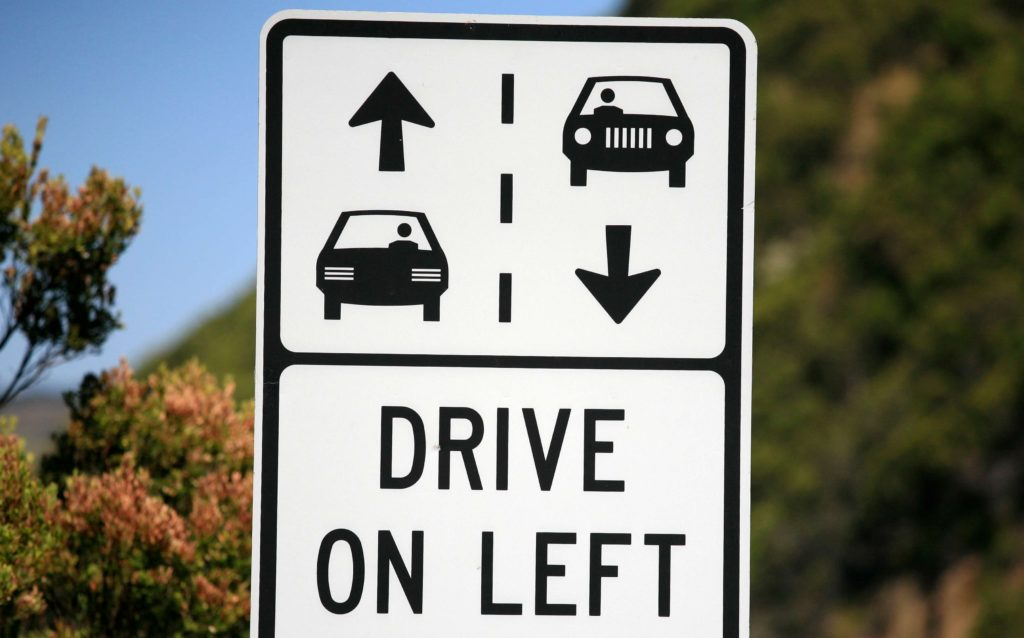6 design business habits that kill grocery
Sometimes our reflexes, caused by the instinct of self-preservation, can be fatal. For example, when you cross the road in Russia, you need to look first to the left, and then to the right. But in England it’s the opposite: first to the right, then to the left. If you forget about left-hand traffic - you can get under the car.

When you switch from a design business (for example, a web studio or an outsourcing development company) to a grocery one (developing and launching your own solution on the market), the same thing happens. It is difficult to avoid the usual approach to business. IIDF Accelerator Director Dmitry Kalayev spoke about the six habits of the project business that prevent the grocery from growing, and in the most difficult cases, they kill the startup.

In the project business, a client comes to you to solve a specific problem, and often this task arises only in his business. The client draws up the terms of reference, and you are paid for its implementation. For example, you have a web studio or an outsourcing company: you sell your expertise and man-hours. And perhaps you have a department that outsource development for an American startup or company. If the startup is successful, the department has a sense of ownership, but in fact it still acts as a contractor for this American company and does not make business decisions.
If we compare the design business with the grocery business, the same patterns of behavior do not always lead to the same consequences for different types of businesses.

For the project business, conducting many projects simultaneously is beneficial. You have a dozen customers: one of them delays payment, the other changes the contractor. This could cause a cash gap, but due to the fact that you have other customers, you do not sag. This diversifies the company by industry and helps with recessions.
For the grocery businessdefocusing is death. You “smear” resources within one company into dozens of small products - at the same time you make slack, trello and a semblance of facebook in the consumer market. Ultimately, you create an all-in-one product and don’t solve a specific customer problem. That is - do not show the result, increase the risks and lose to competing companies, where the whole team works to create an understandable and simple product with limited functionality.
Therefore, in the grocery business at the start, you need to focus on one segment. And move to a neighboring segment - only when there is an understanding that your company has become a leader in its segment and confidently conveys value, and the sales process has already been built.

In the design business, you sell your expertise to a client who has money. If he sets an adequate task and is ready to pay for it, and your company can solve it, this is your client. The exception is if the project business has abundant orders, and he can afford not to take orders from less interesting customers.
In the grocery business, you need to learn how to choose "your" customers - focus on a specific narrow segment, sufficient for rapid development. And one of the skills that should be strongly developed in the grocery is the ability to refuse "not to their" customers .
If the product is not ready for sale to a potential customer, and significant development or creation of a new product is required - do not immediately drop everything and go make a product for it. It is better to put this customer request in the "piggy bank". And when you have accumulated a certain number of customers with a request for a similar product, you can begin to think whether it is worth doing for this niche.
The task of the founder of the grocery business is to find a mass market where there are orders of magnitude more customers who suit our product. And do not redo the product for every request of a new client.

By and large, it is enough for the project business to ship the software product to the client, and the process tuning, marketing and sales of this particular product are already on the client side.
In the food business, it is not enough just to draw up a statement of work and coordinate the result with the customer. Firstly, competencies in product management are required to experiment with different versions of products, refining to spend minimal resources on this, in order to ultimately create the product that the client needs.
Secondly, when the product is ready, the founders have a feeling that further sales and marketing will happen by themselves. Or they are perceived as one of the smallest parts of the business: either 0 or no more than 10-20% of the development price is included in the company's budget for launching a product on the market. The founders think: "We made a cool product, then it will spread and sell itself."
In fact, getting to the market usually costs more than developing the finished product - because in addition to the cost of marketing, this cost includes serious competencies in marketing and sales. Knowing your product better than anyone is not enough to make it a better business. A product is not something that programmers designed and tested, but you released, a product is something that a client began to buy. From the end of development to the purchase of a product by a client, there is still a lot of work that is simply missing in the design business. Therefore, to become the best business in the segment, you also need to have the best sales and marketing competencies, and it costs extra money.

In the project business , a story often arises “we do everything that the client asked” - he votes with money, and therefore has the right to order the functions and scenarios for working with the product that he needs. Here the following happens: the client sent the technical task, he pays for the implementation, the company works on it, fulfills it and thereby increases its value for other clients, including potential ones.
In the grocery businesssuch a reflex also often works: if the client asks and is ready to pay, the company goes to fulfill the request. But in the case of the grocery business, do not forget about roadmap, development strategy, and what kind of product your company makes. Work with features is built in the same way as with types of clients: you see how the planned functions fit into the development of the product - do they complicate or simplify the work of your main client base? For example, you already have 500 customers, and the 501st wants the red Buy button to appear. But this means that the red button will appear not only at him, but also at other 500 clients who already used a product. And not the fact that they will be happy. Therefore, you must be able to balance: remember about the unit economy and the customers you consider target. It means thatfunctions always go through the evaluation process: they will go to the plus or minus to your product for the entire target audience, as they will affect the overall marginality of the business .
There is another good reason to argue with the client - the accumulated expertise. In the food business, you often become a greater expert in the customer’s business than he himself: you have hundreds and thousands of customers with the same situation. Therefore, you bring to the client not only a set of functions, but also expertise in solving the problems that he has. Therefore, you also know what customer requirements do not need to be met - they do not lead to a result.
In project businesses, however, it is not always possible to penetrate deeply into business processes and begin to transfer expertise from one client to another so that you can safely tell the client which functions should not be done, because they will not bring results in terms of business goals. Subjective opinion must be supported by arguments and cases.

When I ask colleagues who have left the project business how they can earn more, they always say: "We will add features." For the project business, the “more features = more money” rule works. Moreover, if the company does something according to the technical task of the client as a contractor, it cannot track how the added functions affect the client’s profitability. Work with the client ends at the stage of acceptance: when the product is launched, there are no bugs, and the client is happy with everything.
It happens that this rule also works in the grocery business.. Suppose a company made a product that compiles a working calendar for employees in retail depending on load. Solving the problem of "making as much money as possible on the client," most likely, the founder will decide to add more integrations, speed up the calculation process, etc. If all these features will be paid extra - the scheme works.
But in fact, the question “how can a client pay more” is not about features, but about value: if we come to a store with 5 employees with this product, the benefit from it will be an order of magnitude less than for a store with 50 employees. The issue of value is governed not by the number of functions, but by how your client uses them in their activities: whether he can earn more on them or reduce some costs thanks to them. The grocery business is not about features, but about the result for the client.
In addition, for the food business there is an opposite dependence: “more features = less money”. In some cases, features, on the contrary, worsen sales: one of the well-known companies first added the ability to buy plane tickets to the site, then book hotels. And after adding the last feature, the company lost revenue: the conversion fell by 2 times, and the check did not grow. Therefore, it is important to think carefully about what functionality the result will show, and how functions affect money. The development process in the food business does not depend on acceptance by the customer, but on whether the amount of money in your company’s account with a new function decreases or increases.

In the design business, companies can take an advance payment for work, break down the payment by stages, or get the full amount based on the results of work - it is often beneficial for them to start shipping services for free.
In the case of the grocery business, having a finished product right away is not necessary at all. Even before developing a product, you can check whether the customer is ready to pay for it: this way you will receive confirmation that the product means something to the customer. But it is worth remembering that promises to the client must be kept.
Any shipment of the product for free does not answer the question of whether the client receives the result . Only the “money ahead” system shows how interested the customer is in your product.

“It turned out that I have experience working on both sides of the barricades: in the design business and in the grocery. Since 2004 - I am the director of the JetStyle digital agency, where I tried several times to create internal products that could not be successfully developed - the main business was eaten by the unborn.
In the design businessResponsibility for the final result lies not with the contractor, but with the customer. The contractor can be arbitrarily responsible: for example, we are not advocates of the “take any money if they give it” and “do whatever the client asks for” approach simply because our client profile is “long client”. For such a client, it is important to demonstrate the effectiveness of the combination of his and our specialists - this is very similar to our grocery approach. Despite this, we really always only have a fragment of responsibility: we can engage in the implementation of UX, but we cannot be responsible for the final user value, “underwater” client processes. We just do our job well, but it is the client who decides what is most important now, what to direct money and efforts to. If the task is set correctly by the client - for us, as for the project business,
A good project manager in custom development is the person who reformulates the customer’s request in terms of applied goals and then implements the project. His main concern is that the client gets a predictable effect in the contour of his goal.
As soon as you start working in the product, you immediately find yourself in the "death zone." This is such a strategy in Sun Tzu when the bridges are burned. It is not very important whether you have investments at the first stage, or if you are making a “start on your own” - you are faced with a sudden realization that from the whole spectrum of possibilities you and only you can choose. The task of a good product manager is to be able to keep your focus on the main customer process with all your strength. To do this, he needs to know very well what customers are paying him for, and clearly see what his key client process is. The temptation to “fasten” one more small thing to the product at every moment of time - USEFUL! - very great. This will be requested by investors, the board of directors, partners, customers and friends. Making the wrong choice is scary, but if your product tree instead of a single trunk turns into a bush, you are doomed.
Design and product businesses may also have different approaches to calculating effectiveness. For example, digital parties use the term “performance marketing” where it is customary to talk about “unit economics” in the field of independent technology enterprises. These are very similar approaches, but the difference in details leads to very different strategies and actions. Performance marketing, by and large, comes down to the number of leads and the cost of attraction. The driver is people selling specific tools - ux, targeted advertising, or something else. The important thing is that using this approach it is convenient to find a niche in which your tool is effective and to explain to the client how to order it and what is the effect.
Unit economics adds to the performance marketing the second part of the equation - how much and through what process we earned on the client we brought. Digital is not too interested in it precisely because this part is the responsibility of the client. But when you begin to solve this problem in the context of unit economics, the set of tools, the approach to testing them, and the whole strategy change dramatically.
It is very difficult to feel in practice, while you are on the side of the developer. But once you get it, you will always use this approach, because it is much, much more sensible. "
In order not to miss other FRII articles on the development of IT startups and their products, as well as event announcements, subscribe to the FRII Friday newsletter !

When you switch from a design business (for example, a web studio or an outsourcing development company) to a grocery one (developing and launching your own solution on the market), the same thing happens. It is difficult to avoid the usual approach to business. IIDF Accelerator Director Dmitry Kalayev spoke about the six habits of the project business that prevent the grocery from growing, and in the most difficult cases, they kill the startup.

In the project business, a client comes to you to solve a specific problem, and often this task arises only in his business. The client draws up the terms of reference, and you are paid for its implementation. For example, you have a web studio or an outsourcing company: you sell your expertise and man-hours. And perhaps you have a department that outsource development for an American startup or company. If the startup is successful, the department has a sense of ownership, but in fact it still acts as a contractor for this American company and does not make business decisions.
If we compare the design business with the grocery business, the same patterns of behavior do not always lead to the same consequences for different types of businesses.
Habit 1: “The more projects, the better”

For the project business, conducting many projects simultaneously is beneficial. You have a dozen customers: one of them delays payment, the other changes the contractor. This could cause a cash gap, but due to the fact that you have other customers, you do not sag. This diversifies the company by industry and helps with recessions.
For the grocery businessdefocusing is death. You “smear” resources within one company into dozens of small products - at the same time you make slack, trello and a semblance of facebook in the consumer market. Ultimately, you create an all-in-one product and don’t solve a specific customer problem. That is - do not show the result, increase the risks and lose to competing companies, where the whole team works to create an understandable and simple product with limited functionality.
Therefore, in the grocery business at the start, you need to focus on one segment. And move to a neighboring segment - only when there is an understanding that your company has become a leader in its segment and confidently conveys value, and the sales process has already been built.
Habit 2: “All customers who have money are our customers”

In the design business, you sell your expertise to a client who has money. If he sets an adequate task and is ready to pay for it, and your company can solve it, this is your client. The exception is if the project business has abundant orders, and he can afford not to take orders from less interesting customers.
In the grocery business, you need to learn how to choose "your" customers - focus on a specific narrow segment, sufficient for rapid development. And one of the skills that should be strongly developed in the grocery is the ability to refuse "not to their" customers .
If the product is not ready for sale to a potential customer, and significant development or creation of a new product is required - do not immediately drop everything and go make a product for it. It is better to put this customer request in the "piggy bank". And when you have accumulated a certain number of customers with a request for a similar product, you can begin to think whether it is worth doing for this niche.
The task of the founder of the grocery business is to find a mass market where there are orders of magnitude more customers who suit our product. And do not redo the product for every request of a new client.
Habit 3. "We will make a product, and that will be enough."

By and large, it is enough for the project business to ship the software product to the client, and the process tuning, marketing and sales of this particular product are already on the client side.
In the food business, it is not enough just to draw up a statement of work and coordinate the result with the customer. Firstly, competencies in product management are required to experiment with different versions of products, refining to spend minimal resources on this, in order to ultimately create the product that the client needs.
Secondly, when the product is ready, the founders have a feeling that further sales and marketing will happen by themselves. Or they are perceived as one of the smallest parts of the business: either 0 or no more than 10-20% of the development price is included in the company's budget for launching a product on the market. The founders think: "We made a cool product, then it will spread and sell itself."
In fact, getting to the market usually costs more than developing the finished product - because in addition to the cost of marketing, this cost includes serious competencies in marketing and sales. Knowing your product better than anyone is not enough to make it a better business. A product is not something that programmers designed and tested, but you released, a product is something that a client began to buy. From the end of development to the purchase of a product by a client, there is still a lot of work that is simply missing in the design business. Therefore, to become the best business in the segment, you also need to have the best sales and marketing competencies, and it costs extra money.
Habit 4. "The customer is always right."

In the project business , a story often arises “we do everything that the client asked” - he votes with money, and therefore has the right to order the functions and scenarios for working with the product that he needs. Here the following happens: the client sent the technical task, he pays for the implementation, the company works on it, fulfills it and thereby increases its value for other clients, including potential ones.
In the grocery businesssuch a reflex also often works: if the client asks and is ready to pay, the company goes to fulfill the request. But in the case of the grocery business, do not forget about roadmap, development strategy, and what kind of product your company makes. Work with features is built in the same way as with types of clients: you see how the planned functions fit into the development of the product - do they complicate or simplify the work of your main client base? For example, you already have 500 customers, and the 501st wants the red Buy button to appear. But this means that the red button will appear not only at him, but also at other 500 clients who already used a product. And not the fact that they will be happy. Therefore, you must be able to balance: remember about the unit economy and the customers you consider target. It means thatfunctions always go through the evaluation process: they will go to the plus or minus to your product for the entire target audience, as they will affect the overall marginality of the business .
There is another good reason to argue with the client - the accumulated expertise. In the food business, you often become a greater expert in the customer’s business than he himself: you have hundreds and thousands of customers with the same situation. Therefore, you bring to the client not only a set of functions, but also expertise in solving the problems that he has. Therefore, you also know what customer requirements do not need to be met - they do not lead to a result.
In project businesses, however, it is not always possible to penetrate deeply into business processes and begin to transfer expertise from one client to another so that you can safely tell the client which functions should not be done, because they will not bring results in terms of business goals. Subjective opinion must be supported by arguments and cases.
Habit 5. "More features = more money"

When I ask colleagues who have left the project business how they can earn more, they always say: "We will add features." For the project business, the “more features = more money” rule works. Moreover, if the company does something according to the technical task of the client as a contractor, it cannot track how the added functions affect the client’s profitability. Work with the client ends at the stage of acceptance: when the product is launched, there are no bugs, and the client is happy with everything.
It happens that this rule also works in the grocery business.. Suppose a company made a product that compiles a working calendar for employees in retail depending on load. Solving the problem of "making as much money as possible on the client," most likely, the founder will decide to add more integrations, speed up the calculation process, etc. If all these features will be paid extra - the scheme works.
But in fact, the question “how can a client pay more” is not about features, but about value: if we come to a store with 5 employees with this product, the benefit from it will be an order of magnitude less than for a store with 50 employees. The issue of value is governed not by the number of functions, but by how your client uses them in their activities: whether he can earn more on them or reduce some costs thanks to them. The grocery business is not about features, but about the result for the client.
In addition, for the food business there is an opposite dependence: “more features = less money”. In some cases, features, on the contrary, worsen sales: one of the well-known companies first added the ability to buy plane tickets to the site, then book hotels. And after adding the last feature, the company lost revenue: the conversion fell by 2 times, and the check did not grow. Therefore, it is important to think carefully about what functionality the result will show, and how functions affect money. The development process in the food business does not depend on acceptance by the customer, but on whether the amount of money in your company’s account with a new function decreases or increases.
Habit 6. “Ship for free - then we will take more money”

In the design business, companies can take an advance payment for work, break down the payment by stages, or get the full amount based on the results of work - it is often beneficial for them to start shipping services for free.
In the case of the grocery business, having a finished product right away is not necessary at all. Even before developing a product, you can check whether the customer is ready to pay for it: this way you will receive confirmation that the product means something to the customer. But it is worth remembering that promises to the client must be kept.
Any shipment of the product for free does not answer the question of whether the client receives the result . Only the “money ahead” system shows how interested the customer is in your product.
Commentary by Alexei Kulakov, Product Director at Ridero and Director of the JetStyle Digital Agency.

“It turned out that I have experience working on both sides of the barricades: in the design business and in the grocery. Since 2004 - I am the director of the JetStyle digital agency, where I tried several times to create internal products that could not be successfully developed - the main business was eaten by the unborn.
In the design businessResponsibility for the final result lies not with the contractor, but with the customer. The contractor can be arbitrarily responsible: for example, we are not advocates of the “take any money if they give it” and “do whatever the client asks for” approach simply because our client profile is “long client”. For such a client, it is important to demonstrate the effectiveness of the combination of his and our specialists - this is very similar to our grocery approach. Despite this, we really always only have a fragment of responsibility: we can engage in the implementation of UX, but we cannot be responsible for the final user value, “underwater” client processes. We just do our job well, but it is the client who decides what is most important now, what to direct money and efforts to. If the task is set correctly by the client - for us, as for the project business,
A good project manager in custom development is the person who reformulates the customer’s request in terms of applied goals and then implements the project. His main concern is that the client gets a predictable effect in the contour of his goal.
As soon as you start working in the product, you immediately find yourself in the "death zone." This is such a strategy in Sun Tzu when the bridges are burned. It is not very important whether you have investments at the first stage, or if you are making a “start on your own” - you are faced with a sudden realization that from the whole spectrum of possibilities you and only you can choose. The task of a good product manager is to be able to keep your focus on the main customer process with all your strength. To do this, he needs to know very well what customers are paying him for, and clearly see what his key client process is. The temptation to “fasten” one more small thing to the product at every moment of time - USEFUL! - very great. This will be requested by investors, the board of directors, partners, customers and friends. Making the wrong choice is scary, but if your product tree instead of a single trunk turns into a bush, you are doomed.
Design and product businesses may also have different approaches to calculating effectiveness. For example, digital parties use the term “performance marketing” where it is customary to talk about “unit economics” in the field of independent technology enterprises. These are very similar approaches, but the difference in details leads to very different strategies and actions. Performance marketing, by and large, comes down to the number of leads and the cost of attraction. The driver is people selling specific tools - ux, targeted advertising, or something else. The important thing is that using this approach it is convenient to find a niche in which your tool is effective and to explain to the client how to order it and what is the effect.
Unit economics adds to the performance marketing the second part of the equation - how much and through what process we earned on the client we brought. Digital is not too interested in it precisely because this part is the responsibility of the client. But when you begin to solve this problem in the context of unit economics, the set of tools, the approach to testing them, and the whole strategy change dramatically.
It is very difficult to feel in practice, while you are on the side of the developer. But once you get it, you will always use this approach, because it is much, much more sensible. "
In order not to miss other FRII articles on the development of IT startups and their products, as well as event announcements, subscribe to the FRII Friday newsletter !
